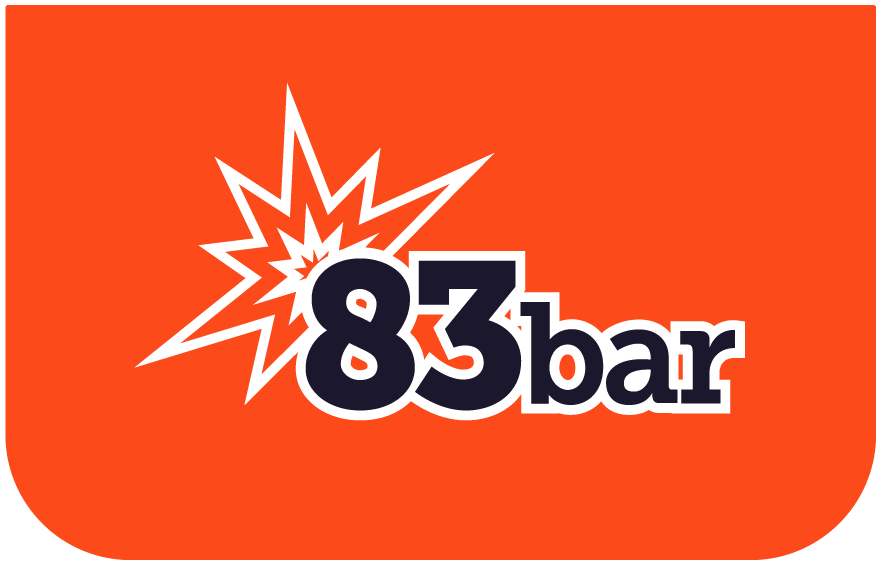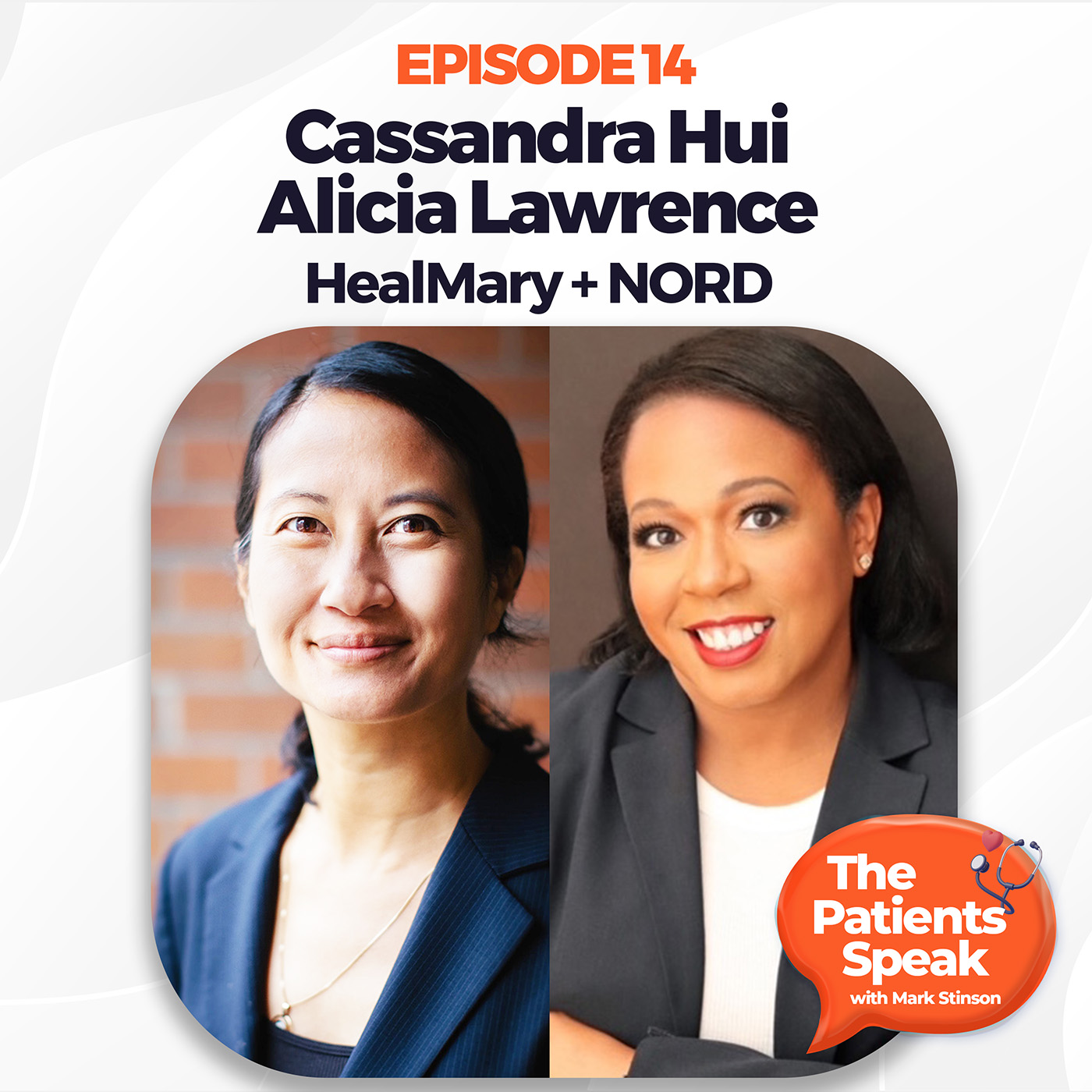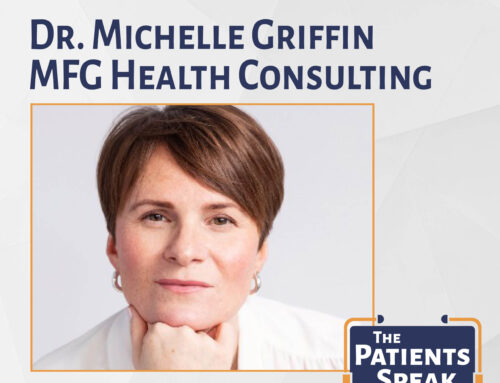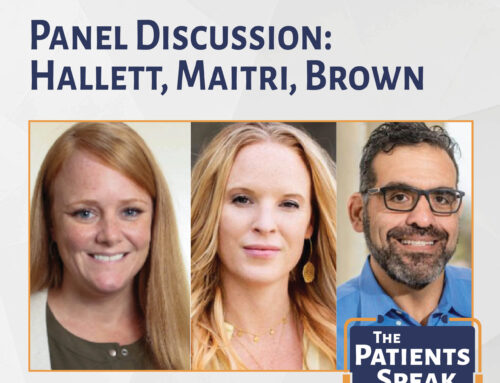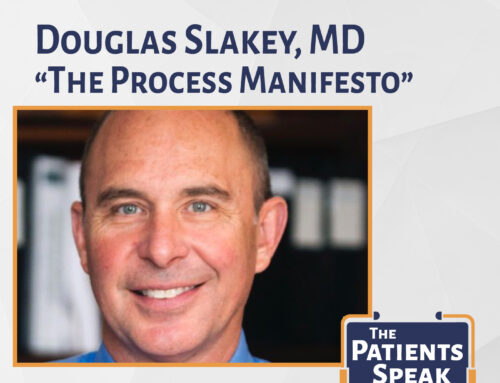Welcome back to our podcast The Patients Speak, our guests today are Cassandra Hui of Heal Mary and Alicia Lawrence of the National Organization of Rare Diseases, NORD.
On this podcast, we combine business and scientific innovation with listening to the patient voice and how they can benefit, and how we can accelerate the patient journey.
Mark Stinson:
Welcome back friends to our podcast The Patients Speak, where we’re combining the business and scientific innovation with listening to the patient voice and how they can benefit and how we can accelerate the patient journey. And today we’re going to talk about rare diseases and cancer and the tools that we can provide patients to find resources and clinical trials even faster and smoother to access new options that they might not know they had before. And my guests are Cassandra Hui of Heal Mary and Alicia Lawrence of the National Organization of Rare Diseases, NORD. Alicia and Cass, welcome to the program.
Alicia Lawrence:
Thank you, Mark.
Cassandra Hui:
So great to be here. Thank you.
Mark Stinson:
Well it’s glad to have you both. As we start just with the theme of our podcast, the Patients Speak, I was wondering if both of you could share what we really need to hear from the patient and Alicia, you have a chance as a patient services case manager to really work individually and one on one with patients. But as you think about those conversations in aggregate, what would be a takeaway? What’s a theme that you often hear that patients say, “I just wish people would understand blank.” What would that be?
Alicia Lawrence:
So I wish there was just a one statement that would work, but patients come with various psychosocial issues, socioeconomic issues. A lot of our patients that call us are looking for financial assistance, whether it be for regular household bills or medical bills or just as we are talking about today, clinical trials specialist. I just wish that I could find a specialist or a clinical trial to help me. I just wish that there were more resources because I can’t work due to my rare disease or I can’t work because I am a caregiver for an individual with a rare disease.
And so we at NORD, especially in our patient services department, we have patient assistance programs, but if there isn’t a program that we have, then my team, the information services team will speak with the caller, email, inquiry and try to find resources for that particular patient or caregiver. So unfortunately it’s not a one size fits all. It really does depend on the needs of the patient, demographically where the patient is. It could be, I can’t find a specialist in my area, how am I supposed to get to… If I live in rural, let’s just say I’m in Ohio, but I need to get to Cincinnati on the other side I don’t have a car that could get me there, how am I supposed to get to this appoint?
Mark Stinson:
So sometimes it’s just very logistical.
Alicia Lawrence:
Yes.
Mark Stinson:
Yeah, very good. Well and Cass Heal Mary as a clinical trial connector and bridge between the patients and some of these trials. It’s got some fascinating technology behind it, but it also is based on a family story of your own. I wondered if you could share that with us.
Cassandra Hui:
Yeah, absolutely. And I love that you started this podcast with you. What do patients want to be heard about? And from my experience being a caregiver to not only my mom who was stage four, but both of my sisters who got it in 2017, got cancer. The idea is for me it was why are options so hard? Why is knowing that there are options so hard? What are those options and how can we make it easier? And so from both the patient side, but what we’ve built was based in that belief is there’s got to be an easier way.
Mark Stinson:
And so taking that personal motivation and applying that to founding your company Heal Mary, what thinking went into… It’s not just a technology play.
Cassandra Hui:
Yeah.
Mark Stinson:
It’s using technology, but maybe give us a little insight into the platform and how it works.
Cassandra Hui:
Yeah, well it’s based on good technology, but as you said that this isn’t a technology play, it’s really about using the technology to make it easier for people like myself who don’t have a science background and were thrust into a situation where you’re trying to understand what is happening and at the same time understand what are the options, what’s out there. I don’t think anyone ever really gets set up to prepare for a rare disease or a serious illness in their family. So when it’s all thrust upon you, it’s very fast moving. And the way that we’ve evolved and why we are so grateful to be speaking with people like Alicia was they helped inform the technology because these are people who are connected to patients who are dealing with those concerns and understanding what the needs are and that’s really what has shaped our technology. So as much as to your point, it’s not a technology play, it’s about using the technology for those people who are interacting with patients or who are patients or caregivers themselves to make the process easier.
Mark Stinson:
And there’s a lot of lists of clinical trials out there. If I went to look for a list, I could probably find one. But as I was playing along with your platform, there seems to be a translation of this into plain English. How does that work?
Cassandra Hui:
Yeah, so dive a little bit deeper into how it functions. Take the emotional out of it.
Mark Stinson:
Yes.
Cassandra Hui:
So it’s based in machine learning. We use natural language processing. So the first step for us was how do we take complicated medical jargon and put it into plain language, plain English right now. And so it functions to be able to give you an easy understanding of what that trial’s trying to do. The second piece of it is we parsed out the acceptance criteria. So using that, can we pull it all out and get a patient to go through that process? The third piece of it is auto matching. So now I’ve got information that I’ve submitted, how do I get auto matched to clinical trials? And we’re currently working on a recommendation engine. So based on the criteria you’ve already filled out, can we proactively tell you which trials you’d automatically qualify for? Our scraper scrapes every single day so that this is in real time that this information is coming in.
Mark Stinson:
Alicia, thinking about what that might mean to the patient to read about a clinical trial in language they could actually understand, how do you think they would react to that?
Alicia Lawrence:
So just the go back when we first met with Heal Mary, that was some of the things that we did discuss. For a patient or caregiver or whoever is especially patient and caregiver, you don’t want them to feel overwhelmed by the process of clinical trials. Just the word itself just seems overwhelming. And so it’s really important that when we give information to our patients and caregivers that it’s information that’s easy to find. It’s not going into a website and then trying to look for whatever it is that you are trying to obtain. It’s seeing as soon as you open the website what you’re looking for and to be able to put that information in there right away and get the information back.
And also as to Cass’ point, making sure that it’s information that they can understand. Because again, I’m also a social worker by trade. So for me the emotional tie to it is I don’t want to have to go into a website or a resource and find that I have to then try to understand the clinical jargon for lack of a better word.
Mark Stinson:
Yeah.
Alicia Lawrence:
And so we try to really be able to work with organizations that understand that. That when a patient is coming to us or coming to you, the anxiety of having to figure out these resources in itself isn’t overwhelming enough. So it’s just really nice to be able to provide a resource to a patient that is just user friendly.
Mark Stinson:
And thinking about the patient who is looking, let’s continue this thought on clinical trials. What is their interest? Is it I want another option, I want to help research? And again, it might be different and personal, but what do you hear from patients who say “Maybe clinical trials are something I should look into?”
Alicia Lawrence:
So it’s a little of both. You have patients who want to be able to find out what options are available to them with their particular diagnosis, what are the clinical trials available. However, you do have patients who say, “I want to be able to participate in the research part of finding cures for my diagnosis. Where do I go to get that information? Where can I go to become to participate in those programs?” So we do get it for both. Both looking for other options as well as participating in research. We do get it from both ends.
Mark Stinson:
Okay. And Cass, Heal Mary you were talking about parsing out some of the inclusion and exclusion criteria. This is a big deal for study sponsors, for site coordinators that they don’t get a lot of people who are just shopping or wouldn’t ever be qualified or aren’t even interested. How are some of the study sponsors reacting to this tool?
Cassandra Hui:
I think it’s a pretty exciting time right now in terms of the progress that’s been made and largely I think to the [inaudible 00:10:49] really forcing clinical trials to the forefront and the difficulty of actually accessing that information or those trials. So it’s really been a time in which I think that a lot of where red tape existed before doesn’t necessarily exist anymore or as strongly. And so I think sponsors have been super interested in finding better ways to connect to patients. And what we’ve shown and continue to show is that patients are pretty engaged and pretty informed about their personal health. And so why would you not give them that option to be able to provide for their own search and to be able to understand for themselves what they’re agreeing to when it comes to their personal health. And I think we’ve reached a really critical point where if people are so engaged and informed about their own health, why can we not give them the option of understanding what they would like to do?
There are some people motivated by science for sure donating to wanting to find a cure. There are some people who want to save their own life. Why not let them choose [inaudible 00:12:00] that best suits their needs? And I think nowadays, sorry taking it back to the sponsor side, but I feel like sponsors understand that and what we’re really looking for is how do we start to narrow the connection so that it’s a lot easier for everybody to participate and for everybody to win, for everybody to access those treatments, for sponsors to actually have people participate in their study. So basically we’ve got quite a bit of interest from sponsors as to what we’re doing. And really I think that’s what’s important about the social impact that we’re trying to make. It’s really about what benefits everybody who’s participating.
Mark Stinson:
Yes.
Alicia Lawrence:
And I do think that’s important too because… I’m sorry, Mark.
Mark Stinson:
Please.
Alicia Lawrence:
I do think that’s important too because for a patient to want to participate in a clinical trial, it has to upfront be something that they feel comfortable with. It has to be something that they feel if they move forward, this person, I can trust these people to help me through this process. I think that’s really the other key to it too. It’s, yes, like Cass said, making sure that the sponsor is aware, being the liaison between the two and understanding that bridge and making sure that the patient who is looking for a clinical trial feels comfortable enough to be able to participate.
Mark Stinson:
Exactly.
Alicia Lawrence:
And feel like they have a support. Because when a patient… Should it be a patient starts to feel like they’re not being heard, then they will not want to participate.
Mark Stinson:
Yes. Makes sense. And Cass, this idea that the patients still have so many questions that they want answered and would love to talk to somebody live, who could knowledgeably explain what’s going on. The presenters of this podcast 83bar, is a company with that kind of nurse staffed call center capability that I think you’re partnering with to try to extend what you do and add this personal touch. Maybe you could tell us about that.
Cassandra Hui:
Yeah, definitely. I think first and foremost the platform was built for organizations like NORD who already have that support, who have the people in place like Alicia who are able to take on patients and help them walk through all of their options and find those sorts of supports in place for them. But we do get an overwhelming amount of patients coming to us directly through some link that they saw in some digital group that was being passed around. And so they’re coming with us with not necessarily the same support systems.
And so 83bar, we’ve partnered with them because they provide a call service in which [inaudible 00:15:08] nurse will be able to walk them through the clinical trials that they’ve selected, walk them through what it means, double check that their acceptance criteria would qualify them. Because trust me, nothing is more disappointing than going through a really long process and finding out that you don’t qualify. So getting that up front so you can continue your search elsewhere. 83bar provides all of that service for a patient. And that’s why we’ve really are excited to be partners with them because that is an area in which we are not the experts. We happily build technology to be the bridge, but we are not the experts in the disease like people who’ve worked in it and have that experience and people like 83bar who have a team of nurses readily available to help patients.
Mark Stinson:
Wonderful. Alicia, I think about a specific case that I was listening to your interview on Connecticut NPR just a while back and it was a call-in show, so it was like, okay, all comers. And sure enough, somebody called with just the kind of conversation we’re having right now. This person had a litany of questions, “How do I do this? Logistically where do I go? How do I fill out the form? Who do I talk to?” And you actually asked to take it offline probably to have this kind of one-on-one conversation. So how is that capability, the ability to talk one on one with a patient about their options, How does that add to their, I guess, comfort or this empathy that we do want to show a patient who is facing a rare disease condition?
Alicia Lawrence:
Yeah. So with that particular patient, she had so many questions as it related to a diagnosis, and again, you can hear the emotion in her voice, the overwhelming feeling that she might have been having. And so when we get those kinds of inquiries and we get them via email, we get them via phone. Really when it’s an email, I will tell that person, let’s set up a time to talk. Because I’ll say, here’s my information, respond to this email and let me know when we can speak. And when we do talk, they are, they’re just like that caller that you heard when I did the interview. It’s like, how do I do this? How do I do that? How do I do this? But it’s just all of that emotion. And so what I try to do or what we try to do at NORD is to be able to let them know, “Hey, we’re going to help you, let’s talk about what it is first that’s really most important to you.”
And I go through the whole thing with that person that called, we were able to get to what some of the issues were that were concerning her as it related to the diagnosis. And I was able to give her resources for pretty much all of the things that she had questions for. And by the end of it, she was just so thankful and didn’t even know that places like this existed. And so really that’s the beauty of being able to have these resources and provide this information to patients and caregivers. Because a lot of times we at NORD say, “Alone, you are rare, but together we are strong.” Because of the fact that you do sometimes in that case feel alone. No one knows, no one is there to help you, no one understands what you’re going through. And so to have someone on the other side know what that feeling is, its very helpful.
Mark Stinson:
Yes. And Cass, I project ourselves now into the boardroom of a pharma or biotech company or at the university with the medical directors and clinical coordinators and so forth. And many of us on the inside, we think everybody knows this. So in the meetings you’ve been in, how have you been able to bring this patient experience or point of view to the conversation?
Cassandra Hui:
And it’s an interesting point you bring up because I think people do understand and probably have had a similar issue themselves in that they probably know someone or someone close to them has been ill before. But what’s interesting is when you look at the focus of the work that they’re doing, as it should be, their focus is on the science and on how do we make this work and how do we put in their necessary safety rails and how do we put in… And so I feel like on the clinician side and from the side of the sponsors, the focus on the patient is not necessarily the thing that they’re most concerned about. Because, and again, this is part of the role is they have a lot of efficacy that they have to prove that it works. You can’t release this on a public without proving that there is some substantial science behind it. So with reason, that’s their focus. And so the patient voice is maybe not necessarily the first thing that they think about.
And I think, in this day and age, it’s coming more to the forefront, but I think in all of the meetings that I’ve been having is always to start off with that patient voice and the fact that I myself have been through this three times. So it’s not coming from hypothetical. And I think that’s the important thing is that is our positioning of bringing it in is just as a reminder. We know they know, but we know that’s also maybe not their focus at this time.
Mark Stinson:
That’s a good point. And Alicia, when you have a seat at that table or if you project yourself into those conversations, I like what Cass is talking about. It’s like, yes, they’re focused on the protocol, but how do we keep the patient voice in the center?
Alicia Lawrence:
I tend to always remind them of a patient, the patient’s voice. It’s important for me just from what I’ve seen in my career experiences that sometimes the patient’s voice does get lost. And so when they’re not able to advocate for themselves, it’s important to me to be that person to advocate for them. And so when I do have conversations with organizations like Cass, and I’m sure she remembers, I said, “Well how does this work for a patient who’s…” I always incorporate a patient, a caregiver, especially patient and caregiver or any family member, how is this information or how is this service going to impact? Are you able to reach all areas? Are you able to provide the supports that are needed should a patient call?
Mark Stinson:
Very good.
Alicia Lawrence:
So I always keep that in mind in speaking with… Being on that side of the fence. Yes.
Mark Stinson:
Exactly. Very helpful. And Cass, let’s project ahead a little bit. The subtext of our podcast is the healthcare innovations accelerating the patient journey. How does your platform and some of the things we’ve been talking about here today really speed up, accelerate? The patient wants to go from diagnosis and illness to at least a better state of wellness. How does this help?
Cassandra Hui:
Yeah. And I can really only speak to it through what we’ve done at Heal Mary in terms of how we’ve tried to accelerate the clinical trial experience and a lot of that’s around our machine learning. So automating a lot of the processes and the matching and the difficult things that you would have to do over and over again. I think there is even just the fact that in our platform you are able to share certain clinical trials that you’re interested in with your practitioner via email or via text message. You are able to get informed the minute a new trial matching your criteria comes out. And so in terms of the search and seeking portion, I think that’s where we’ve made the most amount of progress.
From here there are other things we’re putting into place, again, automating a lot of the things that might take a manual person to be able to do. So working with 83bar, having it automated so that a nurse [inaudible 00:24:01] in touch with a patient within a couple of hours. Those things that you have to wait for, you had to wait for a medical professional two or three weeks for an appointment to actually review those versus now we can put them in touch with a call center right away. The other features are multi-language, so we know that if you’re like me and you have immigrant parents, English is not their first language, so why not put it in their first language so that they can understand for themselves what’s happening. So circling back, really, I think that the focus here is really just automating the things that are taking forever for people to do.
Mark Stinson:
And Alicia, you mentioned right up front that there is no one patient journey, they’re all on a different journey and the paths and the obstacles and the ups and the downs are certainly different and difficult. But how do you think some of this technology and some of incorporating more of the patient experience can help improve the patient journey?
Alicia Lawrence:
I think it’s just like what Cass said, without this technology be that patients would have to wait an extended period of time to get the information that now is so readily available. I do often think about the patient who does not have a computer, but having a call center, like how we have a call center, someone will say, “Oh, we’ll email you the information.” And they’re like, “Well, I don’t have the capability to get email. Is there another way?” “Sure we can mail it to you.” “But I really need that information now.” And I’ll say, “Well, let’s sit on the phone and I will give you every number that you need.” And so it’s being able to be flexible depending on what the circumstances of the patient is.
And so with the technology, it speeds up the process. Whereas before it was maybe it wasn’t even that you had the access to go and go on a computer and be able to look for this information yourself, you had to wait for your doctor to do it and your doctor’s office and that could take two or three weeks for them to get back to you. And you’re sitting home thinking, “Oh my goodness, what’s taking them so long?” You don’t want to call because they’re probably with patients. So this alleviates all of that. And so it is something to be that I’m sure many people are thankful for.
Mark Stinson:
Well it’s that combination of technology and what you were saying. It’s like let’s just connect with the patient wherever and however we need to. Right?
Alicia Lawrence:
Mm-hmm.
Mark Stinson:
Well what a fantastic conversation. I can’t thank you both. My guests have been Alicia Lawrence of NORD and Cassandra Hui of Heal Mary. It’s been a great conversation about patients and technology to help find clinical trials as an option. Thank you both.
Alicia Lawrence:
Thank you.
Cassandra Hui:
Thanks so much for having us, Mark.
Mark Stinson:
And we’ll put all your links and connections in the show notes so people know how to find you and learn more about your work.
Alicia Lawrence:
Great.
Mark Stinson:
And listeners, come back again next time. We’re going to continue these conversations with healthcare leaders as we’ve been talking about how to accelerate the patient journey and how various technology, clinical, and scientific and business innovations can help speed up that process. So join us again for our next episode when we listen to The Patients Speak. I’m Mark Stinson, we’ll see you soon.
